Part Five - Other European "Free Men"
Chapter 7 - Germany & Austria
While every occupied nation in Europe had its patriotic underground movement, backed up and directed by their "Free Governments" in London, there was little organised resistance within Germany itself. However, as Count Klaus von Stauffenberg's attempt at Rastenberg to assassinate Hitler demonstrated, there was a strong anti-Nazi element within Germany and Austria.
In addition, the Soviet Union maintained an effective underground intelligence network through devoted German communists. But while these tended to be concentrated in the industrial complex of the Ruhr, they were not particularly Allied enamoured by the death and destruction descending on them from the USAAF by day and the RAF by night.
Nevertheless, both SOE and various sections of the SIS maintained a "German Desk" while Washington and Moscow also had their own organisations on active service within Germany and Austria. Such undercover activities had relatively more success in Austria, where hostility against the Anschluss still lingered, particularly in the south-east of that country where there was an active resistance movement by the Slovenian minority. Thus the German prison camps in Austria close to the Yugoslavian and Italian borders were a better springboard to freedom than most others.
This was particularly true of the Stalag XVIIIA at Wolfsberg and Stalag XVIIID at Marburg (Maribor) which was even closer to the borders of Yugoslavia and Hungary. The Slovenian town of Semic became the virtual nerve-centre for group escapes through Yugoslavia to liberated Italy (K1).
Stalag XVIIIA was more of a transit camp where Allied POW, particularly those from Greece and Crete, had all their details listed and card indexed, before they were drafted out to various "arbeitkommanos" throughout Austria. Many Allied POW who did manage to escape but were re-captured were returned to Wolfsberg for inquisition by the Gestapo before transfer to "punishment" camps (M24).
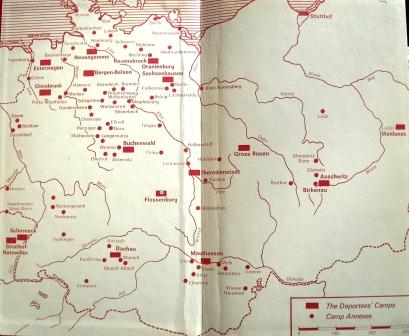
From the Heat of the Battle
To the Frying Pan of the Stalag
To the Inferno of a Nazi Concentration Camp
Stalag XVIIID seemed to have more than its share of gifted POW linguists who were vital to effective liaison with the Slovenian underground movement. Marburg also has many work camps under its direct administrative control. It was relatively easy to break away from such smaller camps and, once in Yugoslavia, escapers could be directed to the various British and American missions established there. These in turn would arrange transport to Allied bases in Italy (HH1).
Austria
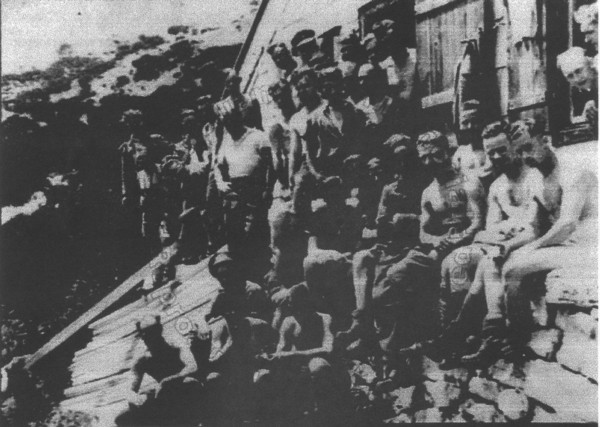
Most AIF POW drew little distinction between Germany and Austria.
Certainly those who were prisoners of the Italians, but rounded up from Italian prison camps and shipped out of Italy across the border to Austria as German POW did not. The Anschluss and dismissal of Chancellor Dollfuss "the only leader to have a life-size portrait on a postrage stamp" were a part of past history that had swallowed up Austria as an independent state.
The Austrian underground was weak and although some attempts were made to infiltrate from Yugoslasvia, and some POW, who had volunteered for special duties were trained by the SOE in Italy, there never was an effective underground army. What little effort was made by both SOE and OSS was only started after The Italian Army had made its armistice with the Allies, but that only prepared an administrative framework for post-war occupation. ("The SOE 1940 - 45", M. R. D. Foot M35 p207/08).
When the POW in Campo 57 - Udine were encircled by German troops after the Italian Armistice was promulgated, two trains took them into further captivity as German POW. One train went through to Stalag VIIA Moosburg, but the other stopped at Stalag XVIIIB at Spittal in Austria still very close to the Italian border. While some ex-Italian AIF POW stayed at Spittal, many more found themselves at Stalag XV111A at Wolfsberg or at Stalag XVIIID at Marburg (Maribor) near the Hungarian and Yugoslav borders.
As the possibility of escape favoured those drafted out to the Italian work camps around Vercelli, so did the work camps surrounding Marburg favour those escaping from there. Many of those AIF POW in Yugoslavia escaped from these camps.
NX1164 Sapper Walter Henry Chrestense Steilberg BEM after many attempts to escape, finally managed to escape from an evacuation march and reached American lines near Weiden on 25.04.45.
References:
A6 appendix 1: "Prisoners of the Germans and Italians", A.E. Field.
The German "Concentration Camps" of Europe
Introduction
In 1964, the British Government received a reparation payment of One Million Pounds Sterling from the German Government for the forced transfer of those British POW who, “as punishment”, had been transferred from Geneva-supervised German Prison Camps to Concentration Camps controlled by the Nazi Gestapo. Such illegal transfer was a war crime.
This original compensation payment was made to British Imperial POW only. No payments were made to Colonial troops. The Canadians in particular were most upset. The USA made their own arrangements to cover their own men through direct negotiation with Germany.
In August 1944, 164 Allied airmen from the civil prison of Fresnes in Paris, were transferred by train to the Concentration Camp of Buchenwald in Central Germany - 81 were from the USA, 47 from the UK, 29 from Canada, 9 from Australia and 2 from New Zealand (see D3). The Canadians have produced a documentary film - “The Lucky Ones” covering the Buchenwald incident.
At about the same time in that summer of 1944, from different Stalags within Germany and her occupied satellites, another Allied group of “enemies of the State” was being sent to the Little Fortress of Terezin, the jail section of the ghetto of Theresienstadt, in the former Sudentenland district of Czechoslovakia. Among those destined for Terezin were - 21 New Zealanders, 17 Australians and 21 British (see D11, D19). Paul Rea (D11) has also produced a documentary film - ”Death Wears A Smile” partly filmed in Terezin.
There were Anzac POW transfers to other Concentration Camps as well.
The huge complex of Auschwitz played host to at least 7 Australians and 5 New Zealanders. One of them, Donald Watt, tells his story in his book “Stoker” (D9).
In addition, 1 more New Zealander and 10 Australians finished up in Dachau, Flossenburg, Lublin, Mauthausen and Stutthof. There may be others as yet unidentified.
From all German concentration camps, “The Little Fortress of Terezin” housed 38 of the 69 known Anzac POW involved. This total includes all who, for one reason or another perished while in enemy captivity, or were victims of war crimes there.
This is to underline the difficulty the men from Buchenwald and Terezin faced to even have their immurement officially recognised. This was only achieved in 1987, after superhuman research by the Canadian KLB Club ("Krieg Lager Buchenwald") and the political lobbying of the “Little Fortress Association” in England for Terezin, forced the Australian and New Zealand Governments to recognize their grievous experiences did actually occur.
The pity is that many survivors did not live to receive their just financial compensation, nor, like the Canadian and Australian airmen in Buchenwald, their rights indicated by the Canadian attachment to the USA initiative to obtain further compensation through the International Organisation for Migration section of the United Nations for having been the victims of a war crime.
The Nazi System of Concentration Camps
When Adolph Hitler's National Socialistic German Workers Party (The NSDAP or NAZI Party) established the Third Reich of Germany, from his power base in Munich his personal bodyguard, the Schutzstaffel (SS), developed a Secret State Police system - the GEheimsSTAats POlizie (GESTAPO).
To “concentrate together enemies of the State”, in 1933, the Gestapo set up its first “Concentration Prison” at Dachau, a village near Munich as a prototype for other “Concentration Prison Camps” to house political enemies, trade unionists, gypsies, homosexuals and other "undesirables". Having established the system and procedures, it's first Commandant, Theodore Eiche (later bearing the title of Inspector of Concentration Camps), moved on to head the Waffen SS Toten Kopf (Death’s Head Division) and it’s infamous black uniform.
Dachau was the first of the deliberately planned series of "Extermination Camps" for such "undesirables". Its first inmates were nearly all "undesirables" who were German Citizens - Germans who had committed criminal acts under existing law, who belonged to German communistic-orientated trade unions or even of other German political parties. These German citizens were incarcerated at first in individual cells with a bed, cupboard and a chair.
Rapidly, as the list of "undesirables" grew, even these items were removed, several prisoners being pushed into the same space. Eventually even the beds were replaced by slats. Finally even these vanished. Soon a single cell was home to 15 prisoners. But before that, some German citizens had served their sentences and returned to their German families.
The crematorium at Dachau was never used!
Dachau is now a suburb of Munich, but the nucleus of the camp buildings have been retained and is now a National Museum, along with Buchenwald, Sachsenhausen and Ravensbruck. It was the first Concentration Camp to be built on German soil.
When WWII started with the invasion of Poland, Theodor Eiche and his Waffen SS Deathshead’s Division was first across the Polish border.
By the time Germany hosted the Olympic Games to a worldwide audience, the infamous complex of "Concentration Camps" of Belsen-Bergen, Buchenwald, Flossenburg, Mauthausen, Ravensbruck (for females) and Theresienstadt (for families) was spreading as a cancer throughout Germany and especially in its re-occupied Sudentenland, part of Czechoslovakia. The system of “Concentration Camps” was in full swing by 1939 when WWII began and proliferated as the Third Reich expanded throughout Europe bringing millions more "undesirables", "guest workers" and POW into the Fatherland.
In the spring of 1940, the Gestapo head - Heinrich Himmler - decided to build a new Extermination Camp near a bleak little town called Oswiecim, 30 miles west of Cracow in Poland. This was to become Auschwitz, the largest and most infamous of the "Vernichtungslager" ("Extermination Camps").
As the war developed, Auschwitz grew to seven times its original size, acting among other activities as a tremendous reservoir of slave workers, whose longevity was brutally decided by the amount of work that could be got out of them before they entered the ovens. It was also to become the centre of the Holocaust. It was not only to use the then most modern extermination technology to eliminate German “undesirables”, but the genocide of all Jews in Europe.
When in 1987, the then Australian Prime Minister, Bob Hawke, established the Concentration Camps Committee in Canberra to investigate claims from Australian servicemen about the time they spent in German Concentration Camps. They sanctioned ex-gratia grants of $10,000 to 27 Australian POW - 17 from the AIF and 10 airmen. They were allocated as follows (D2):
1. Auschwitz - 7
2. Buchenwald - 8
3. Dachau - 2
4. Flossenburg - 2
5. Lublin - 1
6. Mauthausen - 1
7. Stutthoff - 1
8. Theresienstadt (Terezin) - 6
1. Auschwitz
The Auschwitz Concentration Camp Complex was part of "The Final Solution” established by Hitler’s Third Reich.
Laurence Rees, in his book (D1) does not accept the generally-held belief that the extermination concentration camp of Auschwitz was conceived and established as the prototype to implement Hitler’s pledge to completely annihilate the Jewish race. While the death roll finally reached 1.1 million unfortunate souls, certainly not all were Jewish, nor were the “guest workers” and slave labourers who were sent to Auschwitz II (Birkenau) or Auschwitz III (Monowitz-Buna), that vast industrial complex, which include factories producing synthetic fuel and rubber. Buna and asssociated factories were among the many reservoirs of labour destined for the crematoria of Auschwitz when they could no longer usefully contribute their labour to the Third Reich.
Auschwitz reflects the “dynamic realism” of the entire Nazi regime to become the world’s supreme power, and to use whatever labour was available and expendable to achieve that end.
It rationalised the assembly line technique first developed by the Ford Car Company in the USA. But human lives, not auto components were the input materials. Those sent to Auschwitz I (the main camp), were registered, tattoed with a number, undressed, deloused, their body hair shaved off and their clothes disinfected with Zyclon-B gas. They were sorted into those who could still contribute to the running of the camps and those, including children, who were immediately marched into the gas chambers. If those included Jews, all the better. If they happened to be Allied POW being punished for escape attempts, too bad!
There were 2 types of “aussenarbeitskommandos” (work camps). Those attached to Geneva Convention controlled prison camps and those outside the Geneva Convention that were controllled by the Nazis. Of the 27 known Australian POW who were later to receive compensation for their illegal transfer from “normal” prison camps to Gestapo controlled ones, 7 were sent to Auschwitz. Don Watt, of the 2/7th Bn was among them. He has written of his experiences in his book - Stoker (D9). Other Australian writers such as Alex Barnett (D5) decry this fine distinction. He was in Stalag VIIIA/Goerlitz, but sent out as a slave labourer to work in an I.G. Farben paint factory near the spa town of Bad Warmbrunn. There he worked alongside other labourers of many nationalities in very poor conditions. But while akin to the "aussenarbeitskommandos” of Auschwitz, his “outside work camp” was a separate work place from the main camp still officially attached to Stalag VIIIA. Alex was later to be moved around Germany in a senseless march but managed to survive the War.
Anzac POW sent to the Auschwitz Complex
AIF
NX23444 Warren George Brown BEM - 2/1 Ordnance - 05.07.1991*
VX45822 Roy Edward Lauder East - 2/3 LAA - (still alive)
VX34554 William Sidney Harrison - 2/24 Bn - 30.04.1990*
VX6429 Leslie Daniel Marsden - 2/8 Bn - 09.06.2005* (paid after appeal)
NX20137 Edward Leonard Morgan - RAE - 06.03.1994*
NX30962 Harry Robert Richardson - 2 A Tank - 13.08.1991*
VX8006 Donald Watt - 2/7 Bn - 28.05.2000*
* Indicates post-war date of death.
NZEF
64861 Lloyd G. Doel
John Parfitt
Thomas Benjamin Thompson
VX45822 Roy Edward Lauder East 2/3 LAA Regiment
Roy East was captured in Crete in May 1941. After spending several months in the German Transit Camp at Salonika, he was taken by train with hundreds of other Allied POW to Moosburg, near Munich. Of the 102 men from the 2/3rd LAA who ended up in various German prison camps, Roy East was one of the 31 that initially finished up in Stalag 344 - Lamsdorf.
He then spent some time in various “aussenarbeitskommandos” in various places in Czechoslovakia and Poland. But due to his "fractiousness" rating by German authorities, he was packed off to a “punishment camp” located at Brno, in Poland. Brno, or Bruenn in German, was opened on October 1st, 1943. It was a branch camp of the Auschwitz “Extermination Complex” - the very centre of the Holocaust.
This was one of the “reservoir” camps through which passed a never-ending stream of civilians who, for one reason or another, were being removed to cleanse the Third Reich of undesirable citizens. But before reaching Auschwitz itself, they were used to make a final contribution to the German war effort by being forced to work as labourers in the most horrible of living conditions.
For nearly six months nobody would know what happened to him. So far as his unit, his family and the Red Cross were concerned, he had simply vanished. He was then suddenly returned to his Stalag 344. There he was greeted by piles of letters, papers and Red Cross parcels.
But more privation and anxiety were yet to come. When the Russian armies fought their way into Poland, the Germans decided to evacuate the 35,000 POW then held in Stalag 344. While most were moved away by train, some 1,500 in work camps were made to march through cold european conditions, almost as bad as those at Brno.
For nearly five months they were force-marched west from Poland through Germany towards the French border. They finished up at Hagen, near Essen. But by this time the Allies had crossed the Rhine. So his POW “rag-tag mob” were turned around and started to march back again eastwards.
This was the last straw for Roy East and his mate George Bunting. They decided to play dead. They managed to drop out of the march and remain in the vicinity of Hagen until it was liberated by the Americans. Brno too, was evacuated in January 1945, its then inmates being transferred to Bergen-Belsen.
On his repatriation to the Eastbourne Reception Camp in England, he didn’t say much about his time at Brno as “it was not the sort of things one talks about".
On his return to Australia after being discharged from the AIF, Roy dropped back into civilian life with his wife and four daughters. He joined the Victorian Police Force, and eventually retired with the rank of Superintendent.
However, on his own initiative when the Concentration Camp Committee Enquiry was started in 1987, he submitted a claim for having been illegally transferred from Stalag 344 to the Concentration Camp at Brno. His claim was accepted and he was given the ex-gratia payment of $10,000. The CCC publicity lead him to giving the oration at the Shrine of the POW Reunion in February, 1986.
VX6429 Leslie Daniel Marsden 2/8th Bn
Les Marsden enlisted into the AIF at Wangaratta on October 19, 1939. After the first Libyan campaign, he went with his battalion with the Sixth division to Greece and Crete. In Crete he was one of the 96 men of the 2/8th Bn to be taken prisoner by the Germans - he became German no. 92707 at Stalag VIIA (Moosburg/Isar). Les reports:
"Dave Lang and I were in the same room in Stalag VIIA. We were working together in the same party of about 30 men in the railway yards of Munich shovelling snow, or whatever else we were told to do by our German boss - Larry Adler.
"We had been discussing escaping for some time and Dave dreamed up the idea of using the rope from parcels we received from the Canadian Red Cross parcels. There was about 5 ft. of thin rope to tie up the Canadian parcels. We asked the 4 barracks in Stalag VIIA - each barrack had about 120 POW each - to save up the rope to make 4 hammocks. Dave’s idea was to use the rope hammocks to swing under a train going to Switzerland. Some of the men were working in the goods shed and around the station. They found out information from the time tables and platforms trains left for Switzerland. There were four of us in the escape plan, Dave Lang, Taffy (a Welsh mate - I can’t remember his name), Ted Longland [QX99 Edward Allan Longland 29 Bn AIF] and myself.
"We arranged to catch the train at about 2 am that night. But a severe blizzard blew up that night. The temperature was about 30 degrees below. Ted and I decided we would freeze under the train with the strong wind and blizzard, but Dave and Taffy went ahead with the escape as planned. About three weeks later, Dave sent us a letter in code to say they had made it to Switzerland.
"I met Dave in Melbourne in Flinders St. near Young and Jackson’s after I arrived home in 1945. I was with my father, and a chap dashed across the street and nearly knocked me over - It was Dave! He told me the train took them right to Geneva. They were wondering how to find the British Consulate. While walking down the street, they passed two men talking English. Dave bumped into one and when he spoke to him, told him they were escaped POWs and what they needed. The men directed them to the British Consulate which took them in, keeping them there until flights home were arranged - me to Australia and Taffy to England. To this day I have never met Dave again after that meeting in Melbourne.”
David Lang won the DCM for his escape into Switzerland.
The winter of 1944/45 was one of the coldest winters ever experienced in Europe. The war was closing in on Germany. As the Allies advanced towards Berlin on two great fronts, German POW were force-marched from one camp to another.
Les claimed to have been transferred from Stalag VIIA to Stalag 344 Lamsdorf near Poland and escaped from there in the 500 mile march from that camp, being recaptured and sent as punishment to six weeks in a Concentration Camp there. This was not validated by the CCC consequently his application for payment was refused. This was overturned on appeal in 1990.
New Zealander John Parfitt's story
Private Memories of Hell Remembered
The memory of a German guard shoving a gun in his face and threatening to shoot always remained a vivid memory to John Parfitt.
Captured by the Germans during the fighting in Tobruk in December 1941, John was handed over to the Italians as Libya was regarded by them as an Italian theatre of war. John eventually finished up at Campo 57 Gruppignano, near Udine in the north of Italy.
This was the main prison camp for ANZAC non-commissioned soldiers and held some 4,000 of them at the promulgation of the Italian Armistice in September 1943. One of the conditions of that Armistice was that the Italian army was to hand over all Allied POW to Montgomery’s 8th Army.
But the Germans had no intention of giving up the fight. They moved swiftly to surround Campo 57. They crammed the entire prison population into two trains bound for Germany. John Parfitt ended up in the German “aussenarbeitskommando” of Odenberg in Poland.
In the midst of the freezing winter of 1944, John Parfitt and his mates were sent out to work building a ramp over a railway line. Then guarded by civilians (a breach of the Geneva Conventions which require that military prisoners have military guards) they refused to work. The civilian guards quickly sought military guards. It was then that John had a German gun held against his throat.
But another prisoner, John Durham, convinced the guards that if they killed any defenceless POW they would ultimately face death themselves.
He and his 14 companions were quickly transferred to the Gestapo Concentration Camp complex of Auschwitz as punishment for their resistance to German discipline.
As Russian troops closed in on Auschwitz in January 1945, the Germans withdrew inmates and moved them back into Germany by train. But as the railway system was under constant fierce attack by the Allied air forces, they reverted to massed force marches to Czechoslovakia.
Eventually they encountered reconnaissance scouts from General George Patton's Eighth American Army. Their guards fled. Finally after nearly three and a half years captivity, John was again a “Free Man”.
By the time, he got back to England the war was nearly over. John was sent to a hospital to recuperate. Like many other POW, he seldom spoke of his war experiences - not even to his family.
But when he saw an item in an Australian newspaper about a compensation fund for former POW who had been used as slave labour, he successfully applied.
In Poland, he always believed he would get out of captivity.
That kept him going.
2. Buchenwald
Unlike most other “Concentration Camps”, Buchenwald and other “early built” German concentration camps such as Dacau and Sachenhausen, were regarded initially by the Gestapo as “punishment” rather than “extermination” camps.
Many serving SS men convicted of various crimes, some civil but most military, were handed down various precise terms of imprisonment, when convicted and sentenced. Even among the SS themselves, there were strong preferences as to where such sentences were to be served. Among “punishment camps”, Dachau, in a small village just outside of Munich, was considered the “best” while Buchenwald and Sachenhausen were also considered by them as “benign” camps, if such an adjective can be applied to any German concentration camp.
Buchenwald held 20,000 emaciated and exhausted near-corpses, when liberated by the US 80th Division in April 1945. Among their number were some 600 SS prisoners.
The WO 208/4296 Files on Buchenwald (A9) lists inmates from Czechoslovakia, Poland, Norway, Denmark and France, but do not specifically mention those British servicemen sent there. These files merely mention that some groups may have been kept apart as potential “exchange hostages”.
Among the Germans themselves, Goering, head of the Luftwaffe and Himmler, head of the Gestapo, were frequently at loggerheads about the treatment given to POW Allied airmen. After the mass escaper of airmen from Stalag Luft III Sagan, a furious Hitler ordered the execution of all 69 escapers. Goering, fearing that the British would retaliate against Luftwaffe POW held by them, strongly resisted that decision. The final compromise was that 50 would be executed. The list of those chosen is set out in Lt. Colonel Scotland’s "The London Cage" (M24) p 121.
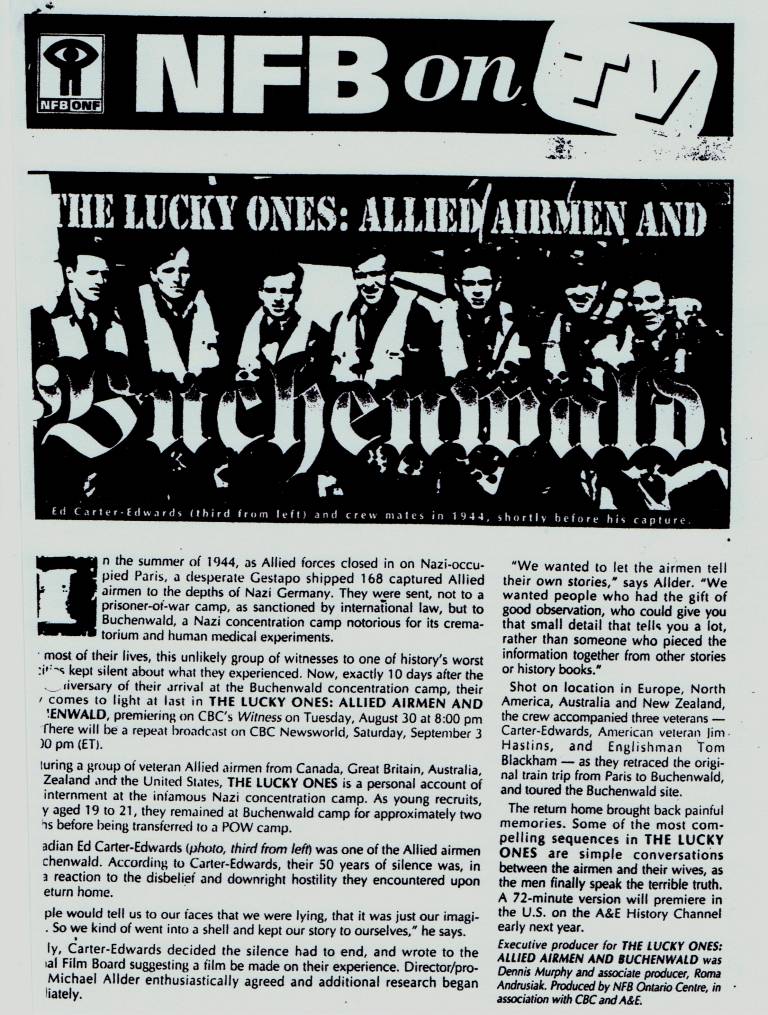
In most concentration camps there was a system of colour coding the inmates attire with patches sewn on to them. This was a system of recognition to assist guards to identify certain groupings. This system of recognition had much of the same identification purposes as the colour patch worn on AIF uniforms. This recognition system while applicable to most inmates did not apply to Allied airmen. In Buchenwald, different coloured triangles with the apex pointing to the ground, with an individual serial number and a black letter indicating nationality, were group identification signals.
Colin Burgess in his exemplary book “Destination Buchenwald” (D2) p 100 lists them:
Red without letters = German political prisoners
Red with black letters = Other nationalities such a F for French, P for Poles, R for Russians etc.
Green = Common law offenders
Yellow = Jews
Pink = Homosexuals
Violet = Jehovah’s Witnesses and others imprisoned for religious beliefs.
Black = Gypsies, “shiftless elements” and work dodgers.
Every inmate was given a Buchenwald serial number. In a personal conversation with Kevin Light, one of the few last remaining survivors from the group of Anzac airmen sent from Fresnes Prison in Paris to Buchenwald, he was surprised to learn that he had "finished" his sentence there just before liberation. Technically he was a ”Free Man”. But no matter whether an evader, being circulated back to freedom through an escape line in civilian clothes as many of the airmen from Fresnes sent to Buchenwald were, or a serial escaper, POW such as Hal Lennard BEM, who ended up at Dachau or Walter Steilberg BEM sent to Terezin Fortress did not have the slightest doubt that being sent to any Gestapo prison was as a virtual sentence of death. The acronym DIKAL {Darf in kein anderes Lager} "Not to be transferred to any other camp" was stamped on their papers (D2).
Anzac POW sent to Buchenwald
Australian
427078 W/O Mervyn James Fairclough# - 78 Sq - 1964* #
43255 W/O James Percival Gwilliam - 78 Sq - 11.08.2002*
418957 W/O Eric Lyle Johnston - 78 Sq - 25.08.2003*
402447 Fl/Lt Kevin William Light DFM - 78 Sq - 19.07.2008*
418755 W/O Thomas Alexander Malcolm - 78 Sq - 15.02.2003*
425954 W/O Keith Cyril Mills - 78 Sq - (Still Alive)
417883 F/O Robert Neil Mills - 78 Sq - 08.08.1990*
415738 W/O Raymond Walter Perry - 466 Sq - 26.11.1997*
417545 W/O Leslie Keith Whellum - 102 Sq - 23.05.2003*
New Zealand
403460 S/Ld Philip John Lamason
421963 F/O Malcolm Ford Cullen
# Eileen Fairclough, his widow, never applied for a payment believing his death in 1964 (before the 1965 Anglo/German Agreement) disqualified her.
* Date of post-war death.
3. Dachau
Dachau was the first of the "designer" concentration camps to be built in the "Greater Germany". Its slogan “Arbeit Macht Frei” (Work Makes One Free).
Originally planned for 5,000 inmates, Dachau was established on March 30 1933, 9 miles North-west of Munich. When liberated by the US Seventh Army on April 29, 1945 there were 27,400 inmates still there.
As well as being the prototype of most concentration camps - the first pimple to develop into the hideous rash that spread across the German face of Europe, Dachau also played an important role in the system that was drawn up to staff and run them - this was the system of “Kapos”.
The commander of a concentration camp, almost invariably an ardent Nazi, would appoint one of his prisoners to be the chief of a section of the main camp or an “aussenarbeitkommando”.
In most work camps attached to Abwehr prison-run work camps, the senior nco would automatically play that role. In actual practice (due to linguistic or other skills, somebody else could be given that authority, if the whole work camp decided that this would be in their best interest). But this was an internal and not an external appointment. It was a fundamental difference between Abwehr and Gestapo controlled camps
One must appreciate the difference in philosophy between the “old” military culture of the Abwehr, the professional German Army and the “new” Nazi philosophy of a “master race”.
In Dachau, Theodor Eicke had preached the SS to be “hard men”. Any form of sympathy between camp commander and the inmates was “verboten”. As "enemies of the state" those inmates were unworthy of that. Any emotion such as compassion or pity had to be immediately suppressed both by Nazi members, of any of their staff. This rule was accompanied by the corollary that at every level of command, any order given would be correct and instantly obeyed. It became one of the most effective training locations for the SS. Dachau is now a suburb of Munich, while the site of the camp is now a memorial.
Anzac POW sent to Dachau
Australian
SX1143 Graham A. Graves - 2/3rd Fld Rgt
VX16735 Harold Paul Lennard - 6 AASC
New Zealand
5860 Colin T. Power
VX16735 Harold Paul Lennard, BEM, Sixth Division AASC, AIF
After his capture by the Germans in Greece on April 25 1941, Hal Lennard was held for six weeks in Camp Korinthia before being transferred to the main German Transit Camp at Salonika.
His stay there was short. On August 16 he arrived at the permanent camp of Stalag 18B - Wolfsburg, in the district of Karnten, Austria, close to the borders of Hungary, Italy and further west, neutral Switzerland. Always somewhat of a loner, he soon decided that a German prison camp was not for him. He immediately began to plan the first of his many escapes.
Realising the difficulty of escaping from the main prison camp, with its doubled guards after dark, searchlights, electric trip wires and dogs, he decided that that he stood a better chance if he volunteered to work in an outside working camp, where control conditions were less rigid. Two days after have been sent out to the “aussenarbeitskommando” at Heiflau in the Steirmarkt district of Austria, on the night of September 19, 1941, he cut the perimeter wire making his way due west across country to Switzerland. Ignorant of the ground difficulties of crossing the Austrian Alps without maps or proper equipment to handle glacial conditions, nevertheless he was free for five days, using the forests as daytime cover and alpine haystacks as sleeping bags. Nearing the town of Steinnach, on the river Inns, he was spotted by a forest warden, who recognised his khaki battle dress and tipped off the local police.
For two days he was held in the local civilian gaol before being taken back to Wolfsburg. There he was sentenced to 28 days - on a diet of bread and water - in the camp gaol.
Lesson One - Get into a work camp, obtain civilian clothes and some sort of a map.
While completing his sentence as winter set in, Hal Lennard began to plan his next escape for April 21, the official opening of the Austrian Spring. He volunteered for a work camp and with the help of the British camp leader at Wolfsburg, was assigned to the small “aussenarbeitskommando" - Radmar, well west of Wolfsburg, so already on the way to Switzerland. During that winter, by exchanging his watch and gold ring with a French POW, he managed to get together a civilian outfit and a German Esso road map. Staying on the roads, travelling only at night in the hope of picking up a freight train heading west, he travelled for six nights covering 130 miles before being picked up again at a river crossing near Bischohafen. It was back to Wolfsburg for another 28 day detention.
Lesson Two - Don’t travel by night on roads. Many roads were only patrolled at night while a person travelling alone is always suspicious.
But having used the work camp ploy twice, Hal was now forbidden to volunteer for work again. Nevertheless, by using the name and German prison number of a friend, he managed to infiltrate himself into another work camp - Nicholsdorf, as a base for his third attempt.
Hal now knew it was desirable to travel as far as possible, in the shortest time possible and with the lightest load possible. Since all trains were closely patrolled, and with petrol restrictions prevailing, stealing a car was impractical. He decided to settle for a bicycle! On June 25, 1942 he slipped away from Nicholsdorf, on the very first day after his arrival there. Changing into civilian clothes, he mingled with some local Germans, stealing a bicycle from the nearest village. After three days cycling, averaging 100 km per day, he reached the small town of Worgel, 62 km north of Innsbruck. Worgel lay at the bottom of a very steep hill. Unfortunately the bicycle chain broke as he came down this hill. Hal went careering through the main street, collided with a cart, severely straining an ankle. After a week in the town gaol, it was back again to Wolfsburg for another 28 days!
Lesson Three - While the formula for a successful escape is right, bad luck can happen once but not twice.
Once again by bartering Red Cross food and cigarettes with the French, he collected a decent escape kit. By some “dishonest methods” he again attached himself to a work party, escaping and stealing a bicycle on which he managed to reached Schladming, a small town on the river Inns, about 350 km from Switzerland. He cycled through Bischofhafen, Kitsbuhl, St. Johann, Schwarts, Innsbruck and Landeck. On the evening of the fourth day, he reached Prutz, where he planned to discard his bike and do the last remaining 20 km to the frontier of Switzerland on foot. No detour of Prutz was possible and inevitably, he was detained, interrogated and finally admitted to being an escaper from Stalag 18A. Another 28 days confinement followed!
But Hal was now a marked man - his fingerprints were taken and together with his photograph were distributed to all German camp officials. In addition he had to present himself to the German camp authorities twice a day to ensure them that he hadn’t wormed his way into any more working attachments. In September 1943, he was transferred to the non-working Stalag 13A - Hohenfels in Lower Bavaria
Lesson Four - If at first you don’t succeed, try, try again.
Not surprisingly, Hal Lennard became the first person to escape from Stalag 13A- Hohenfels. He was helped by his reputation and the Escape Club, who through private and Red Cross parcels had managed to smuggle in special maps of Germany (printed on rice paper), wire cutters, compasses and money.
When later again re-captured, he had the ticklish job of explaining why his maps bore the British date of 1942 when he was a POW captured in 1941! He had brought with him from Wolfsburg a suit of dungarees. With this over his uniform, he mingled with a group of German workmen building a sports oval just outside the camp. At the appropriate time, he discarded his uniform, put on the dungarees and with a pick and shovel over his shoulder, walked away to acquire a bicycle. That done, after passing through Parsberg, Dasswang and Belingries, he was stopped by a policeman and questioned, but after producing his forged identity papers, managed to continue on to Ingolstadt. But the policemen was suspicious, had phoned ahead to his colleagues at Ingolstadt where he was picked up. He was soon identified as a phoney.
After some time in the local gaol, he was sent back to Hohenfels to serve a sentence of 21 days in a special prison hut. He had to report to the German Camp Sergeant three time a day.
Lesson Five - The bigger the risk - the bigger the reward
Hal religiously reported in. But he also began to collect a full German uniform from transport personnel bringing rations into the camp. Six months later, on May 24, 1944, dressed in German uniform, he marched a co-escaper, Englishman Cpl R.Wilkinson, through the main gates of Stalag 13A. After passing through the gates, they discarded battledress and uniform for civilian clothes. The two then split up to go their separate ways. But as the usual reportage was no longer made, the Gestapo soon woke up to the fact that Hal and a companion were missing. Knowing Hal’s fondness for cycling and having picked up Wilkinson complete with maps predicting Hal’s route, they soon picked him up at Rossenburg. This was his last escape attempt.
Hal Lennard was now more than a marked man. The Gestapo decided that his repeated attempts to escape were causing them just too much trouble. They declared him an “undesirable” and an enemy of the State.
They sent him to the Concentration Camp of Dachau, with his papers marked “Never to be released”. But luck finally went his way. A German Wehrmacht camp officer there, who had lost an arm on the Russian front, saw he was an Allied POW illegally sent from a proper IRC supervised Stalag and blacked out the “fertig” (finished) sticker on his papers. After four months in Dachau, Hal Lennard was liberated.
He received the BEM, with another serial AIF escaper, Peter Oates, at a ceremony conducted by the Governor-General of Australia, Sir William McKell, in Sydney in 1945.
Acknowledgments and Thanks
Harold Lennard, BEM.
4. Flossenburg
Flossenburg is located near the villages of Floss and Namering near Beyruth. It was estabhlished in the Spring of 1938 and was liberated on April 23, 1945 by the 2nd US Cavalry. It had 93 sub-camps and "aussenarbeitkommandos".
After Dachau, Buchenwald and Sachshausen, Flossenburg was the fourth concentration campto be established. The location was in a beautiful area of mountains and forests. It is said that the location was personally chosen by Himmler, Head of the SS.
On September 1, 1939, while the German army was invading Poland, 981 prisoners were transferred from Dachau to Flossenburg which was a particularly “hard” camp. This move was to establish a training centre for future SS extermination squads.
It was no surprise that Flossenburg main camp was chosen as the place for Admiral Wilhelm Canaris, Chief of Abwehr Intelligence, to be grisly executed on April 9 1945.
It was also where two mates from the 2/12 Bn finished up after having stuck together as good mates do, since they were taken POW together at Post S10 on the perimeter of Tobruk in May 1941.
The duo followed the well-worn trail of working on the wharves of Tripoli unloading German supplies before being shipped to Italy on a boat which had arrived with German troops and did not want to return empty! They landed at Taranto Transit Camp, but were soon sent to the infamous Campo 57, Gruppignano in North Italy.
From there, after the Italian Armistice with the Allies, they were quickly bundled off into the German Stalag VIIIA at Goerlitz. Here they were soon aquainted with the brutality of the Nazi system, but managed to stick together as virtual slave labour in various beet-sugar mills, at Breslau, a paper mill near Dresden and a foundry in Poland. Eventually they were brought back to Stalag VIIIA.
But in the face of the Russian advance during 1944/45 the POWs of Goerlitz were marched westward through Czechoslovakia in appalling conditions. After passing through Chemnitz, the pair made an attempt to escape, but were quickly re-captured. They were sent to the “aussenarbeitskommando” (KDO) of Flossenburg - Lengenfeld, between Zwickau and Plauen. They were able to hang on there until released by American tanks.
They were only two AIF POW in Flossenburg:
TX50 Patrick Joseph Lattin - 2/12 Bn - 05.07.1993*
TX854 Cpl. James "Lefty" Harold Wright - 2/12 Bn - 14.01.1998*
* Date of post-war death.
5. Lublin
The concentration camp at Majdanek was originally constructed on the outskirts of Lublin in 1941 as a normal POW Camp by prison labour of mostly Polish and Russian POW.
The first intake of Camp Majdanek in the late autumn of 1941 consisted of 5,000 Soviet POW. Over the winter they all died of starvation and the harshness of the climate. In October 1942, the camp was converted into an extermination camp for Jews. A gassing facility was installed consisting of crude wooden barracks. These were later replaced by more sophisticated concrete chambers with air-tight steel doors. Carbon monoxide was originally used, but this was replaced by Zyclon-B gas canisters.
15,000 Jews from Slovakia and the Protectorate of Bohemia and Moravia were next to arrive. The “selektion” procedure on arrival sent those capable of work to gangs assigned to agricultural and forestry work. Those too sick, too old or too young were sent directly to the gas chambers.
Estimates of the total number of people who died at Lublin/Majdanek, whether through execution or simply by having the very basic needs of existence denied to them, range from a quarter to half a million. Although mostly Polish Jews, some 6,000 were from Holland.
In retaliation for resistance action in the ghettos and the strong partisan movement that was being organised in the Lublin district, some 42,000 inmates were annihilated in “Aktion Erntefest” (Operation Harvest Festival). This action included the dispatch of 18,000 Jews in one single day - November 3, 1943. Made to line up in front of ditches they themselves had been forced to dig, they were machine-gunned and the ditches filled in. When the Russian Army liberated Lublin/Majdanek on July 24, 1944, only a few hundred prisoners of various kinds were still alive in the camp.
Since 1944, the former camp site has become a memorial. Today the tourist can see the workshop barracks, two gas chamber buildings, the crematorium, some of the POW barracks and a few SS buildings. These events have become well-documented by the film “Schindler’s List”.
The only AIF prisoner in this camp was NX6980 WOII Frederick Henry James Mitchell - HQ 6 Brigade.
His claim for the ex-gratia payment as originally submittedell to the CCC Committee was originally refused. But in 1990, together with two other claims was reviewed, and the ex-gratia payment made.
He was subsequently commissioned and remained in service with the AIF. By July 1, 1950 he was a Captain with the RAAOC. He eventually was discharged on February 8, 1974 with the rank of Lt. Colonel. He died on August 19, 2005.
6. Mauthausen
Mauthausen/Gusen is located in Austria. There were 7
Aussenarbeitskommandos - Linz - Steyr - Melk - Amstetten- Vienne - Elbensee - Wiener Neustadt. Their motto - “Unsere Ehre Heisst Treue” (Our Honour is called Truth).
Often described as the least known of the 16 major German concentration camp complexes, even to the Germans themselves, it was known to the Austrians as “Totenberg” (Mountain of the Dead) or "Mordhausen" (Death Camp). It was also the first concentration camp to be built outside Germany itself (1938), the first to receive non-German prisoners, and the last to be liberated (by the Americans).
The first intake of prisoners were mainly Austrian common criminals with a sprinkling of German ones, transferred from Dachau. They were engaged in its construction from local granite. By 1940, it had spread out to the local village of Gusen. By 1942, construction was completed and the Austrians and Germans were joined by a large variety of prisoners, including Spanish communists.
At liberation, and despite the many daily executions, the camp housed 256,000 inmates. Mauthausen was the last stop for many other prisoners from other camps sent there for immediate elimination by execution.
These included 54 Dutch and British prisoners from the failed SOE “Operation Nordpol”. Despite the assurances of the Abwehr they had been vindictively sent to their death from their holding camp in Rawicz in Poland with their papers marked with a “K” - "kugel" (bullet).
VX6429 Leslie Daniel Marsden - 2/8th Bn, Sixth Division AIF - was German POW No. 92707 at Stalag VIIA - Wolfsberg in Austria (see his story under 1. Auschwitz above).
Another AIF POW NX9934 Frederick William Henry Bush - 2/4th Bn - failed in his claim to have been sent to Mauthausen. As he could not produce the required evidence, his claim was denied. He died in 1984, but his widow, Bonney, lobbied incessantly but without success to have his claim recognised. As with most other POW “Bill” Bush did not join his unit association, nor his local RSL.
But after a return trip to Austria, where he visited and recognised the area in which he had been held, he finally did join the Coldale RSL in NSW. After so much time has elapsed, it seems a pity that his claim was never recognised, when other claims, originally nor proven, were finally accepted.
7. Stutthof-Sztutowo
This camp was located in Poland near Gdansk on the Baltic Sea and was established in 1939. It was liberated on May 10, 1945 by the Russian Army. It had 40 Sub-Camps and external Kommandos and was the first concentration camp created outside Germany.
Originally the camp fell under the jurisdiction of the Danzig Chief of Police. In April 1941, it was re-assigned to become an SS Camp. In 1943, it was enlarged and surrounded by an electric fence.
Stutthof was primarily a forced labour camp. The German Armament Works had a factory just outside the camp, while in 1944 Focke-Wulff established a factory nearby.
Perhaps the best known feature of this camp was “Spanners R.J.S. Soap.”
Professor Rudolf Spanner was the owner of a small soap factory that operated in Danzig. In 1940, he invented a process to produce soap from human fat - "Spanners Reines Judiche Fett" or "Pure Jewish Fat" soap. Hundreds of inmates were executed for the "production" of soap at this camp.
One AIF POW was at Stutthof and that was NX1568 Vincent Lorriemer Pinchin - 2/2nd Bn - who received a payment.
Most were held in "aussenkommandos" - ancillary work camps, of the main Camp. Transfer of POW to a "Concentration Camp" was not permitted under the Geneva Conventions. While the First Geneva Convention of 1864 protected the rights of the sick and wounded prisoners of war, it was not until the Hague Conventions of 1899 that the laws and customs controlling the actions of countries in times of war was negotiated which included how prisoners of war were to be “humanely treated”. With slight modifications signed at the Hague Conventions of 1907, this became the “bible” for the treatment of POW in WWI.
In 1929 another Convention in Geneva dealing solely with the rights of POW and the obligations of the countries that held such POW was spelled out and agreed to by 47 countries, including Britain, France and Germany. This Convention, which later was extended to cover enemy civilians as well as prisoners of war, was signed by Japan but never ratified.
Under the 1929 Geneva Conventions, POW who attempted to escape, if re-captured alive, could only be punished by confinement within a POW camp prison for a maximum period of 30 days, plus a withdrawal of other camp privileges and a reduction in already meagre rations during their time of confinement.
POW who earned the status of serial escapers were illegally sent to Gestapo-controlled punishment or concentration camps, both as a punishment for past escapes and to effectively stop them from attempting more. They were thus deprived of any protection which was their right under the Geneva Conventions or to the privileges provided by the International Red Cross which included precious amenities such as regular food parcels. Such illegal transfers of allied POW between different types of prisons outside those subject to International Red Cross supervision were, in effect, war crimes.
The broad term "Concentration Camps" actually covered different types of camps. Auschwitz, for example, became an “Extermination Camps” or Colditz which became a “Punishment Camp”. The existence of some of these “Punishment Camps” to which Anzac POW who fell foul of the Gestapo were sent, was denied for many years by the Governments of both Australia and New Zealand.
But due to the efforts of many survivors insisting that such camps had existed, the German Government in 1965 agreed to pay one million pounds Sterling to compensate those British POW illegally sent to them. It was not until 1987 that the Australian and New Zealand governments followed suit, not with money provided by Germany, but as ex-gratia payments from their own budgets.
The practical research problem is to determine and record exactly how many such ANZAC POW fell into this category, who they were and to what unit they belonged. Such statistics are not readily available in official service records, nevertheless attempts are still being made to fill in these blanks.
8. Terezin
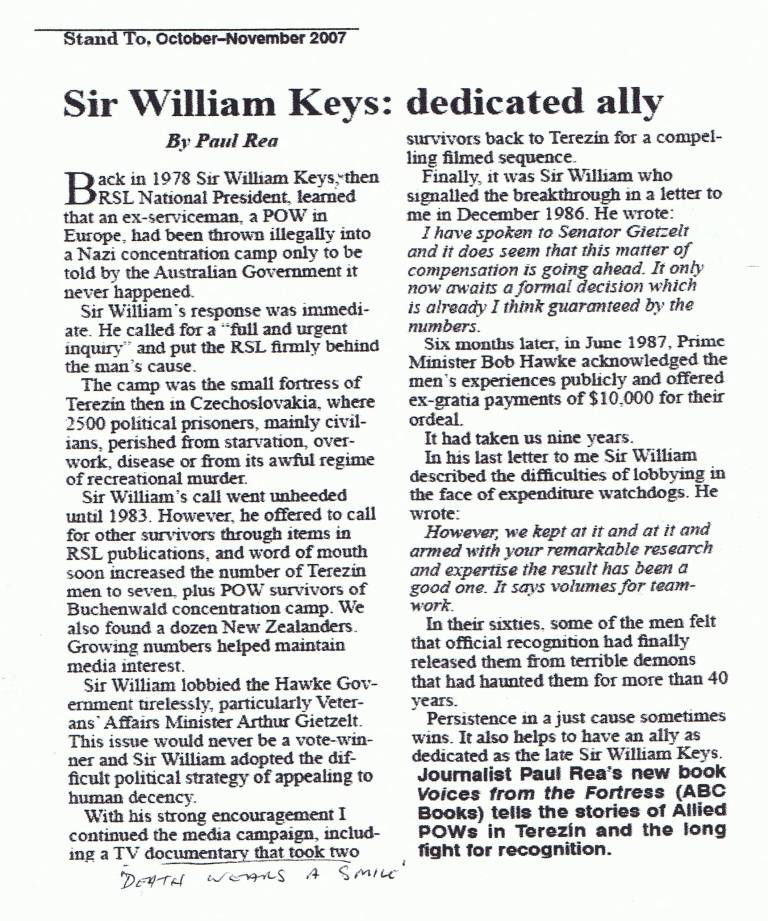
The "Model" Ghetto of Therezienstadt (Terezin)
Terezin is approximately 90 miles north of Prague originally built by Emperor Joseph of Austria. He called the town 'Therezienstadt' in honour of his mother - the Empress Maria Theresa. It consisted of the 'Big' Fortress and the 'Small' Fortress.
The 'Big' Fortress was virtually a garrison town surrounded by ramparts that contained the barracks inside. But it had never been used as a fortress. It remained virtually unaltered and entirely separated by its rustic surroundings.
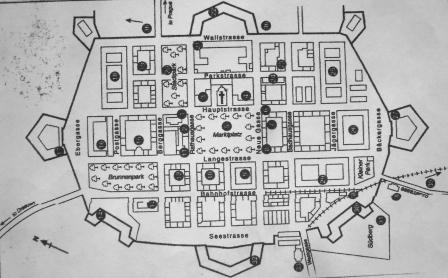
The 'Small' Fortress was used as the prison of the 'Big' Fortress. Virtually built as a bunker, it was considered escape-proof. In November 1941, the Nazi Party took over Terezin to form a Jewish ghetto.
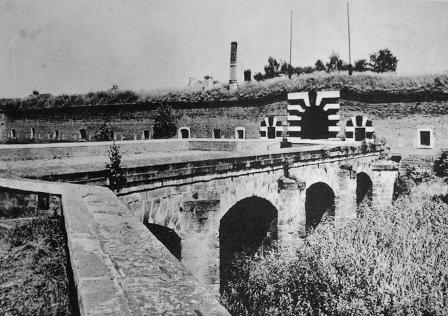
It was portrayed as a Jewish family centre where everything was serene. But it was no more real than a Hollywood set. And when visited by the International Red Cross, the propaganda put out by Dr. Goebbels reached the apogee of deceit.
The Nazis had chosen two groups of selected Jewish men as an “Aufbaukommando” to transform the old garrison town into a modern Jewish ghetto. Their brief was to transform a town that in 1940 had held only some 7,000 residents into a concentration camp to hold almost 10 times that number. Water supply was severely limited and there was no electricity.
To govern the town, they appointed a Jew - Jakob Edelstein - as the “Judenalteste” (Elder of the Jews) to administer the affairs of the town through a “Judenrat” (Jewish Council). Jakob Edelstein was a prominent member of the Czech-Jewish community that was under pressure to move into a ghetto in Prague. He felt it was better to remain in Terezin and not be transposed. But that was a hopeless wish. The ghetto was surrounded by pro-Nazi Czech policemen. The immediate future of its citizens was grim.
Following the visit of the IRC committee, a propaganda film “The New Life of Jews Under the Protection of the Third Reich” was made. But when completed, the actors, including many of the ghetto children, were transported to Auschwitz - sadly to be followed by many of the other Jewish inhabitants. Meanwhile the “Little Fortress” became a concentration camp in its own right.
Payments made to 6 Australian POW in Terezin
NX15488 Frederick Charles Lawrence - HQ 16 Bde - DOD 18.01.2008
NX732 Alexander Cameron McClelland - 2/1 Bn - alive
VX41156 Denis Michael McMahon - 2/8 Bn - DOD 06.10.99
NX45298 Jack Gordon Porteous - 6 Div AASC - DOD 29.01.2008
TX1026 Walter Frederick Riley - 1 A Tank - DOD 24.07.91
NX1164 Walter Henry Steilberg BEM - 2/1 Fld Coy RAE - alive
Payments not made to 9 Australian POW in Terezin as died before 1989
NX597574 Bertie George Alexander - AASC - DOD 11.07.64
WX4777 Raymond Gerald Richard Cameron - 2/11 Bn
VX20126 Jack Clarke - 2/8 Bn - DOD August 84
NX7840 Sgt Herbert George Cullen - 2/1 Bn - DOD 05.12.85
NX8864 Cpl Cecil Charles Froome - 2/1 Fld Amb - DOD 27.11.68
NX4130 Cpl Colin William Haidle - 2/1 Bn - DOD 05.12.85
VX6712 Colin Roy McPherson - 2/6 Bn - DOD 18.01.2008 (??)
NX30962 Harry Robert Richardson - 2/4 Bn - DOD 13.08.91
TX1105 Walter Leslie Wise - 2/12 Bn - DOD 06.07.84
Payments made to 13 New Zealand POW in Terezin
17729 John F. Arnold - 19 Bn
5084 Alfred R. Booker - 19 Bn
NZ41627 Charles Croall OBE - 75 Sq
6783 Sydney Lester Davison - 22 Bn
14939 Bernard Theodore Dynes - 20 Bn
376537 George Albert Helms - NZENG
3281 Roy Lomas - 18 Bn
6996 Francis Paul McLeod - 22 Bn
21026 Gerald Fleming Mills - NZA
8062 Francis K. Morris
7467 Thomas Mottram - 20 Bn
62191 Raymond Robert Jim Reid - 21 Bn
Benjamin Thompson
Payments not made to 8 New Zealand POW in Terezin
8013 Arthur Brooks - 19Bn
47844 Ernest Lionel Nash - 22 Bn - DOD 1984
NZ40142 Warren Sandman
5977 Walter James Seily DCM ASC
39023 Boyd Poukawhai Tamaki - 28 Bn
39024 Wirihana Stephen Tamaki - 28 Bn
5881 Alan Crichton Todd - 20 Bn - DOD 5.7.66
62267 Ernest John Winter - 21 Bn - DOD 24.05 99
The Little Fortress Association
The population of most Axis prison camps ebbed and flowed as various prisoners were marched in and others were marched out. Seldom were any reasons given to those forced to do so. Transfer to the Small Fortress Concentration Camp in Terezin, near Prague, Czechoslovakia was no exception. Those Allied POW sent there as a punishment for repeated attempts to escape, came in at different times, while others, at different times, were transferred to other camps on no apparent grounds.
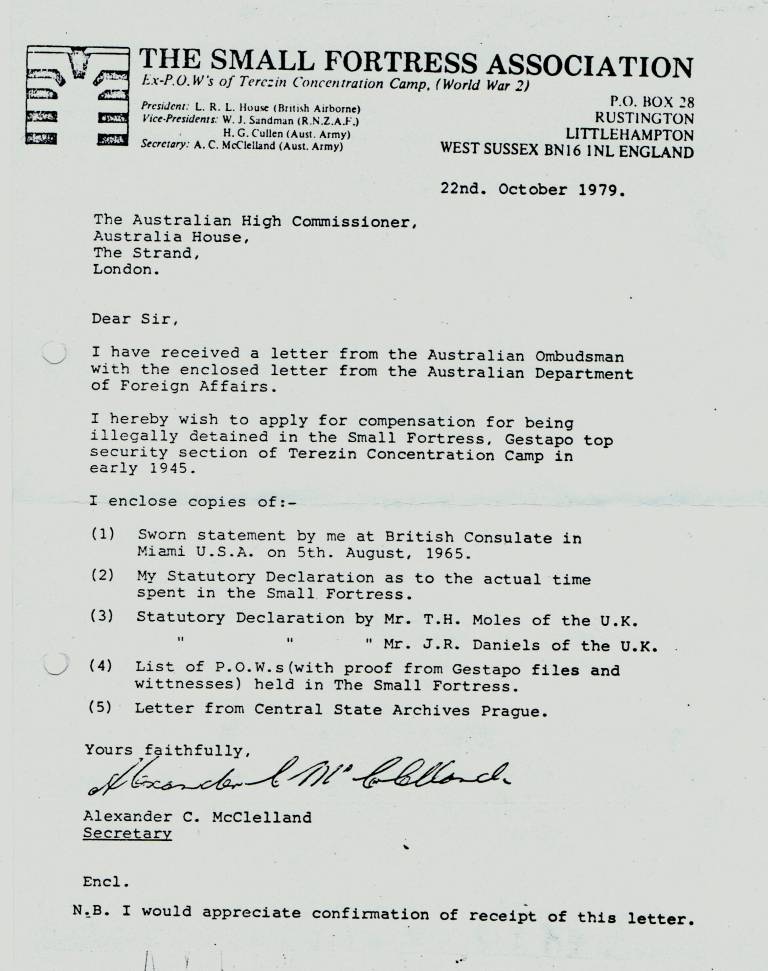
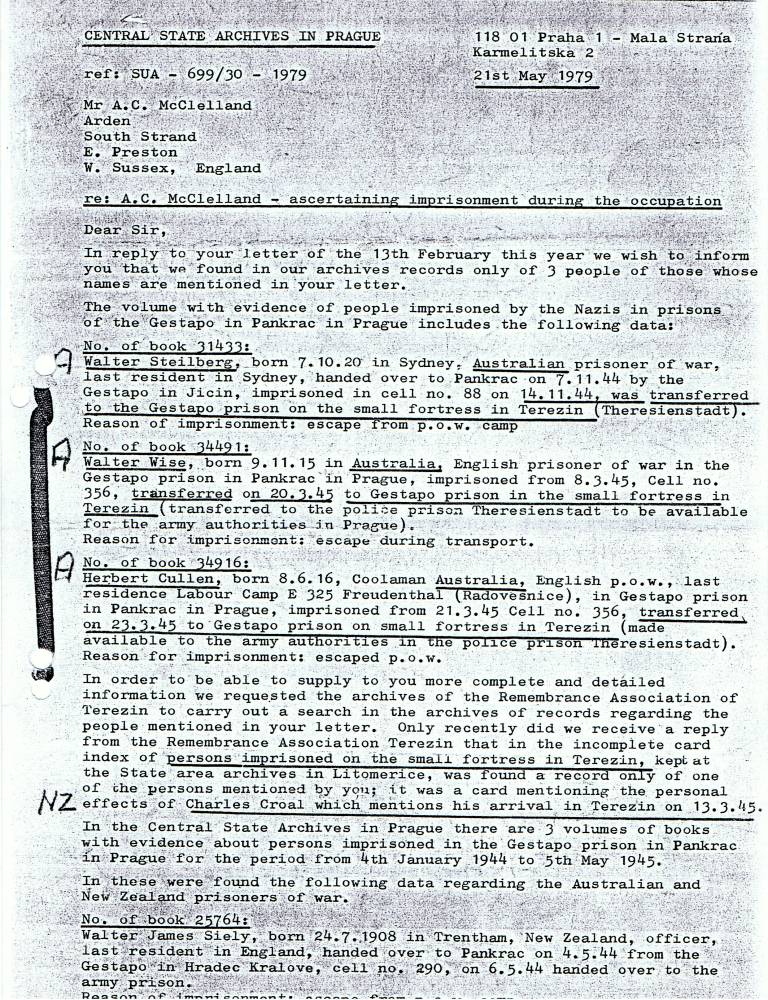
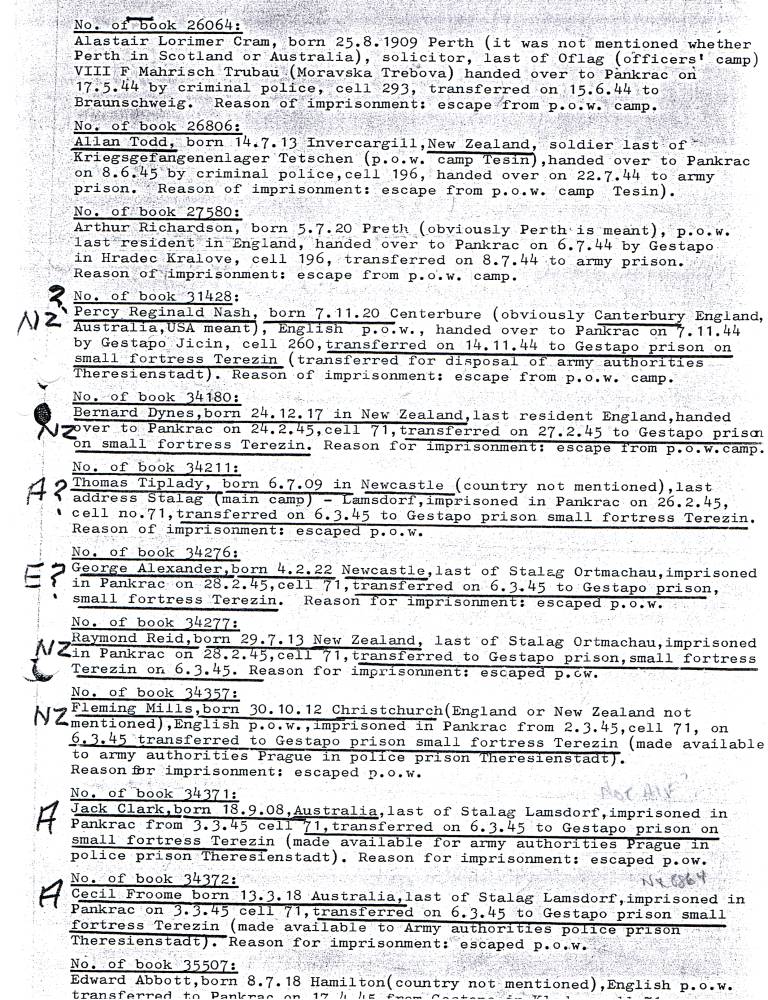
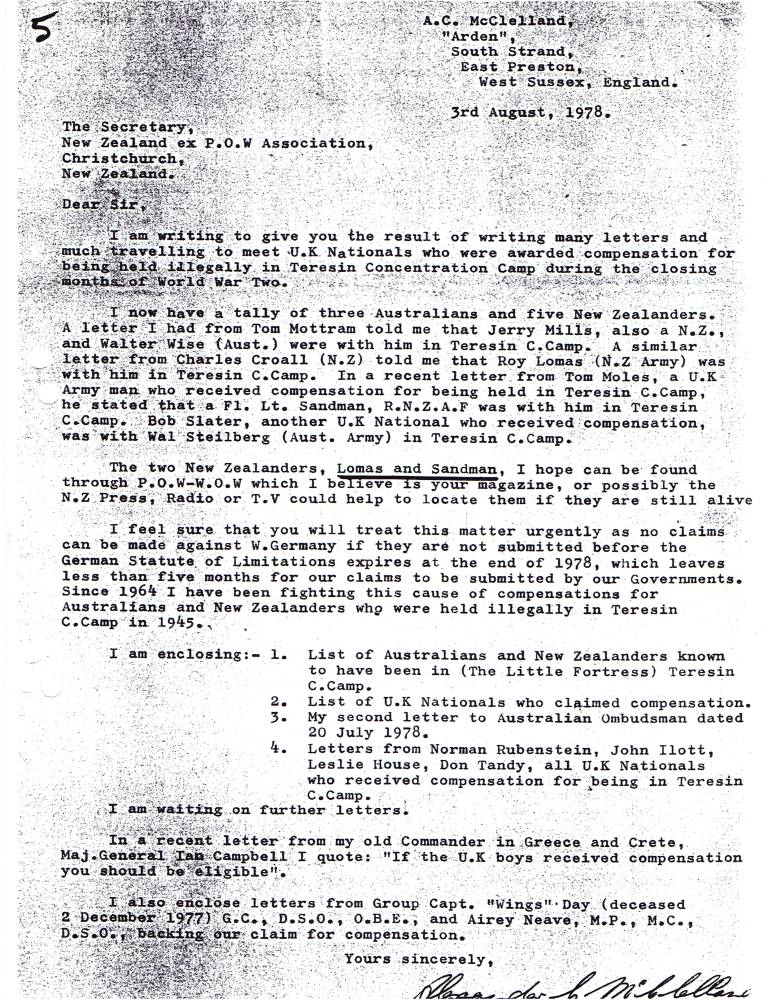
Those within an Axis prison complex, really only got to know those fellow-inmates who shared their particular cells or camp compound. At best, inmates only remember the names of other individuals who were from the same unit, or who they knew in previous camps. The answer to the question “Did you know so-and-so when you were in Terezin?” would be, most times, met with a blank stare and a negative answer!
When "The Small Fortress Association" was formed at Littlehampton, West Sussex BN16 1NL England in 1978, it's President was L. R. L. House (British Airborne). The two Vice-Presidents were W. J. Sandman (RNZAF) with H. G. Cullen (2/1st Bn AIF) and the Secretary was A. C. McClelland (also of the 2/1st Bn AIF).
Their first task was to start making contacts with former inmates of the Small Fortress and to compile a Nominal Roll of the 90 or so British POW who were among the large group of nearly 500 inmates to be “marched out” of that camp in the first week of April 1945 when the Third Reich was on its knees.
Hitherto, the whole existence of “the Small Fortress” had been denied by Allied Military Authorities, but eventually in 1963 the German Government pledged One Million Pounds Sterling as compensation payment for those Allied POW who had unlawfully been sent to German Extermination Camps during WWII.
British claims, including those from Terezin, were settled in 1965. But when “The Small Fortress Association“ submitted similar claims for Anzac POW who had been immured at Terezin, both the Australian and New Zealand Governments continued to deny that any of their European POW had been sent to any Concentration Camps, while they maintained that a Concentration Camp at Terezin did not even exist, except in some POW minds.
Alex McClelland, who was earning a living in England, designing and building boats, noticed a poster announcing the claim by Britain for compensation, while on a visit to Nassau. An RAAF Flt Sgt, Ray Perry, whose punishment-destination for repeated escapes had been an illegal dispatch to Buchenwald, joined him in the fight for recognition on his return to Western Australia in 1965.
But their approach to highly placed politicians (or to anybody with influence that would listen) never achieved any concrete result. Meanwhile the splitting of Germany into two parts complicated the problem of who would pay increased compensation - East or West Germany or both?
It wasn’t until Australian Prime Minister Bob Hawke in 1987 stated “that compensation would be paid to Australian ex-servicemen for time held in Concentration Camps or such institutions”, that there was enough political will to “see justice done” for Colonial as well as for Imperial servicemen. Around the same time the New Zealand Government ensured that their country did the same.
By that time, thanks to access to official Czech records held in the Central State Archives in Prague, “The Small Fortress Association” had quadrupled its contact list from the 3 Australians and 5 New Zealanders on its books in 1978 to 12 Australians and 17 New Zealanders in 1979. In the Prague archives, there were found to be 3 volumes of books with evidence about persons imprisoned in the Gestapo prison in Pankrac in Prague for the period from 4th January, 1944 to May 5th, 1945. There was never any doubt in the minds of Czechoslovakian authorities of the existence of The Small Fortress of Terezin, nor of the names of all the Allied POW sent there.
This information is based on personal correspondence with Herb Cullen and Alex McClelland of "The Little Fortress Association" and is also covered in Paul Rea's Book "Voices From The Fortress" (D11).
The epilogue to "Aussie Soldiers Prisoners of War" (D15) was written by Walter Steilberg BEM, a Terezin survivor.
Acknowledgements and Thanks to:
Colin Burgess
Herb Cullen
Roy East
Elaine Fairclough
Evelyne Johnston
Hal Lennard
Kevin Light
Alex McLennan
Keith Miles
Paul Rea
References:
Correspondence with KLB (Koncentration Lager Buchenwald) Club, 3821 Synod Road, Victoria, B.C., Canada.
Correspondence with Little Fortress Association, PO Box 28, Rushington, Little Hampton, BN16 ISL, England, UK.
K1, D2, D3, D5, M23, D8, D9, D10, M40, M42, A9, D11, D15.
General references: